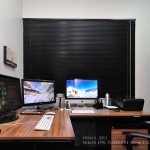I often get questioned about how do I come up with ideas to assemble a proper home-office. How to choose gear, what works, what doesn’t, room size, kind of furniture, etc. I believe there isn’t a right answer to those questions, as we’re all different and we like to do things differently. But I do believe there are a few guidelines that apply to all people. Here they are.
- Have a dedicated room: from experience, I know that working on bedrooms, dining room tables and such doesn’t work. You have to have a proper desk and chair, you have to be able to close the door when you need isolation and you have to keep distractions away. The room doesn’t need to be enormous (mine is actually tiny, the size of a typical Dilbert cubicle for 4 people), but has have enough room for a desk, a chair and whatever else you need to work. Oh, and it must have a door.
- Select the right furniture: furniture doesn’t need to be expensive to be adequate for work. It needs to be functional, period. If you can afford to, have yours custom designed to meet your needs; if you can’t, I’m sure you can find some at your local Ikea that will work. Basically you need a good desk, a very comfortable and adjustable chair (here I will break the rule and recommend a Herman-Miller Aeron), and also some support furniture (shelves, archives, etc) that you might need. I’m a fan of L-shaped desks, so I went for that. I also have a shelf for my books and an archive to file some paper documents that I can’t keep only in digital format. And that’s it. Keep it simple and don’t overcrowd your office with furniture you don’t need.
- It’s all about ergonomics: I recommended an adjustable chair because of ergonomics. The same goes for monitors, keyboards and mouses/trackpads. Your health will thank you later.
- Technology is your friend: if you’re a software developer, then get the best gear money can buy. It’ll keep you happy and every second of extra productivity is worth the price. If you aren’t, then get the best gear you need to get your job done. The next items should help you choose.
- Go ‘Command Center-Mode’: for most people, I’ll recommend a dual monitor setup (or a laptop plus one external monitor) to avoid unnecessary application-switching. Three monitors seems to be the optimum number for software developers. Monitors should be big enough to get all the information you need on the screen (I recommend at least 20” – I have 2 23” and one 21.5” on the iMac). If you can afford IPS panels, then go for it, since they’re much more comfortable to look at. If you have multiple monitors connected to different computers, get something like Synergy to control all of them using a single keyboard and mouse.
- Software is meant to help you: when choosing software, try to keep things simple and get stuff that just works. And keep integration between your software and services simple (i.e. using Google services and Android smartphones/tablets, using Macs and iOS devices, etc). I bet your work isn’t about configuring software, so try to avoid this. Also use productivity tools to leverage your work. There are several apps out there to help you get things done faster and better (OmniFocus, Evernote, etc)
- Mobile professionals require mobile tools: if you’re on the road a lot, then you should get a decent smartphone, a very portable laptop and maybe a tablet (if you do a lot of reading). I also recommend having a proper, powerful workstation at your home-office and also having a ultra-portable laptop, if you can afford it. Use the easy integration criteria to choose your mobile tools.
- Paper is last century stuff: try to keep documents and notes in digital format only. Partly because they don’t take any physical space to store, but mostly because they are searchable. Scan your papers using good OCR software and you’re all set. If you don’t need to keep the paper version, shred it. The paper shredder is more convenient to use than the archive (and more fun). Tip: if you use Evernote, it has embedded OCR abilities, so you’ll be able to search any photo notes you make.
- Keep it comfortable: install blinders if sun is an issue, get an air-conditioner if you live in a hot place. Your home-office should be your dream workplace, not a torture chamber.
- Enjoy it: assemble it in a way that you’ll enjoy it later. Use whatever you think it’s necessary to make it look like you – plants, photos, random junk, whatever. The more you enjoy your workplace, the better will be your work hours quality.
